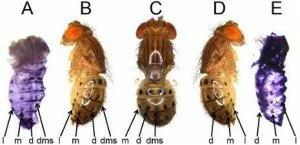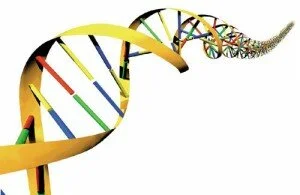
Pupae (A and E) and adult (B, C, and D) fruit flies showing lateral (l), median (m), dorsal (d), and dorsal midline shade (dms) spots.
Spots on the butts of fruit flies are really, really small. But what a researcher and his graduate student are discovering about them could be gigantic.
Thomas Werner, assistant professor of biological sciences at Michigan Technological University, and his PhD student, Komal Kumar Bollepogu Raja, have discovered that three genes that cause cancer and disease in humans also “paint” the spots on the fly’s body. This discovery could enable researchers to study how those genes work in fruit flies and apply that knowledge to treating cancer in people. Continue reading

 Genetics may make some women more vulnerable to the pressure of being thin, a study published in the International Journal of Eating Disorders has found. From size-zero models to airbrushed film stars, thinness is portrayed as equaling beauty across Western culture, and it’s an ideal often cited as a cause of eating disorder symptoms in young women.
Genetics may make some women more vulnerable to the pressure of being thin, a study published in the International Journal of Eating Disorders has found. From size-zero models to airbrushed film stars, thinness is portrayed as equaling beauty across Western culture, and it’s an ideal often cited as a cause of eating disorder symptoms in young women. The Human Genome Project, terminated in 2003, identified more than 20,000 genes in the DNA. These sequences make up just over 1 % of the total genome. The function of all other parts, the so-called junk DNA, that is not protein-coding, was very poorly understood.
The Human Genome Project, terminated in 2003, identified more than 20,000 genes in the DNA. These sequences make up just over 1 % of the total genome. The function of all other parts, the so-called junk DNA, that is not protein-coding, was very poorly understood.